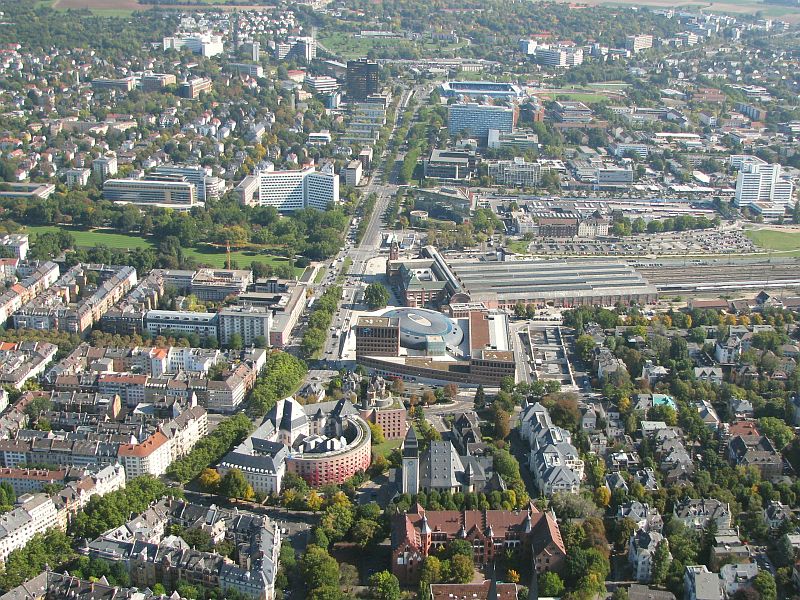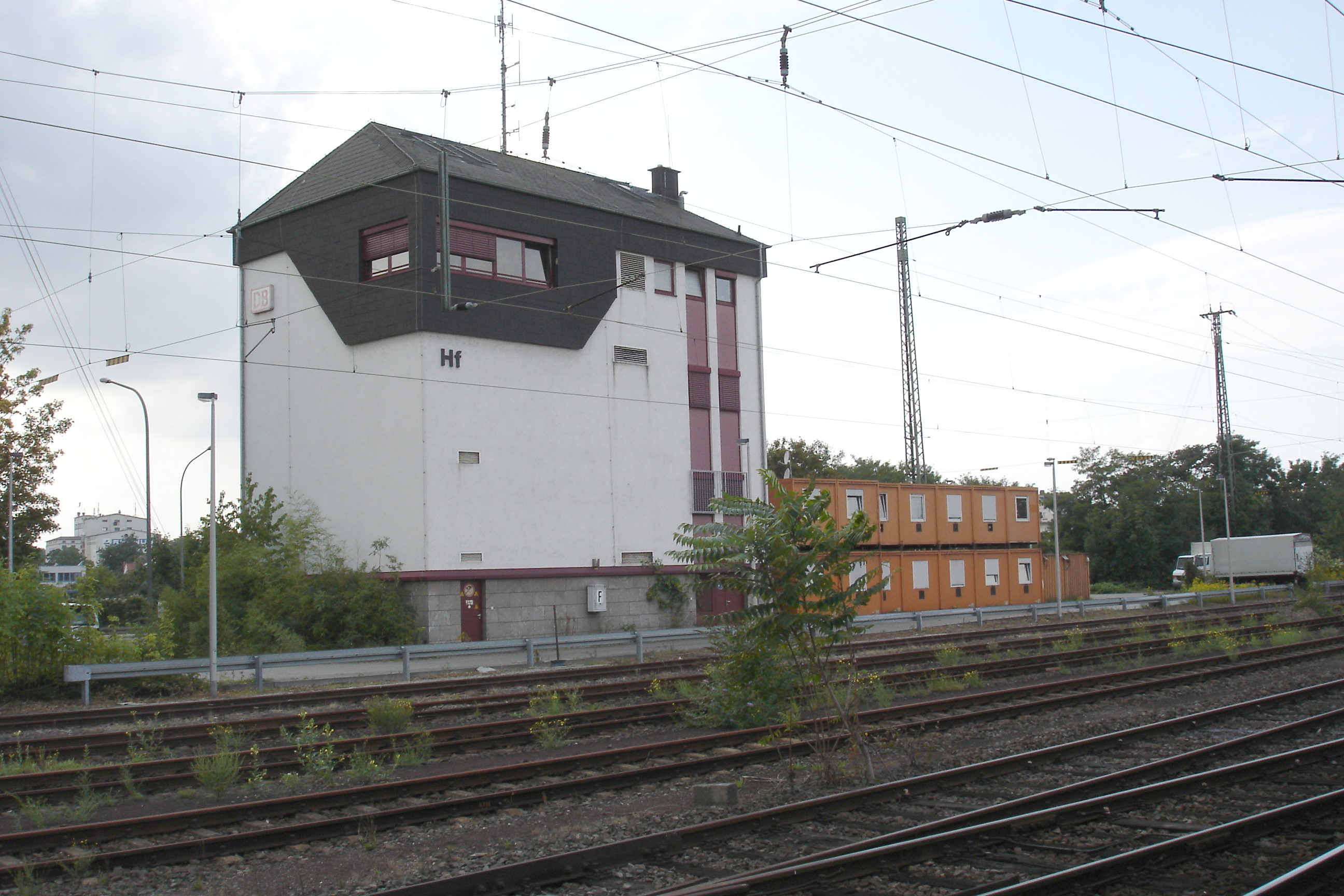|
Steinheim (Main) Station
Steinheim (Main) station is a station on the Frankfurt–Hanau (south bank) railway in Hanau in the German state of Hesse. The station is classified by Deutsche Bahn (DB) as a category 5 station. Location and description The station is located on the South Main S-Bahn line (DB line no. 3680) between Frankfurt and Hanau, which runs parallel with a section of the Frankfurt–Bebra railway (DB line no. 3600). The S-Bahn line is single track here, as it is all the way from Mülheim (Main) Dietenheim station to Hanau Central Station (german: Hanau Hauptbahnhof).The single platform is on the northeast side of the track and is served by trains in both directions. The platform is located on the side of the track away from central Steinheim. This is a somewhat unusual arrangement made necessary because the S-Bahn track runs on the northern side of the line in order to cross Steinheim Main Bridge and to connect immediately afterwards to the tracks on the northern side of Hanau station. The s ... [...More Info...] [...Related Items...] OR: [Wikipedia] [Google] [Baidu] |
Rhein-Main-Verkehrsverbund
The Rhein-Main-Verkehrsverbund (RMV) is a transport association that covers the public transport network of the Frankfurt Rhine-Main area in Germany. Its head office is located in Hofheim im Taunus. Organisation and area covered The RMV is a transportation association operated by 15 counties, 11 independent cities and the Bundesland of Hesse. It was founded 25 May 1995, as the successor of the ''Frankfurter Verkehrsverbund'' (FVV), which was incorporated into the RMV. It is responsible for planning, organising and financing of regional transport, alongside the local transportion organisations. This way, there is a clear distinction between the RMV "ordering" public transport and transport companies carrying it out. As of 2018 there were over 160 transport companies active in the responsible area. [...More Info...] [...Related Items...] OR: [Wikipedia] [Google] [Baidu] |
S9 (Rhine-Main S-Bahn)
The S9 service of the S-Bahn Rhein-Main system bearing the KBS (German scheduled railway route) number 645.9. It is largely concurrent with the S8 service, diverging only to bypass Mainz (which the S8 serves locally). Routes Taunus Railway Main Railway City tunnel The city tunnel is an underground, pure S-Bahn route used by almost all services (except for the S7 service which terminates at the central station). In a short section between Mühlberg and Offenbach-Kaiserlei a line parallel with the South Main railway is used. South Main S-Bahn History This service was first introduced in 2000 to provide an alternative route to Wiesbaden via Frankfurt Airport skipping Rhineland-Palatinate and its capital Mainz Mainz () is the capital and largest city of Rhineland-Palatinate, Germany. Mainz is on the left bank of the Rhine, opposite to the place that the Main joins the Rhine. Downstream of the confluence, the Rhine flows to the north-west, with Ma .... ... [...More Info...] [...Related Items...] OR: [Wikipedia] [Google] [Baidu] |
Rhine-Main S-Bahn Stations
The Rhine-Main Metropolitan Region, often simply referred to as Frankfurt Rhine-Main, Frankfurt Rhine-Main area or Rhine-Main area (German: ''Rhein-Main-Gebiet'' or ''Frankfurt/Rhein-Main'', abbreviated FRM), is the second-largest metropolitan region in Germany after Rhine-Ruhr, with a total population exceeding 5.8 million. The metropolitan region is located in the central-western part of Germany, and stretches over parts of three German states: Hesse, Rhineland-Palatinate, and Bavaria. The largest cities in the region are Frankfurt am Main, Wiesbaden, Mainz, Darmstadt, Offenbach, Worms, Hanau, and Aschaffenburg. The polycentric region is named after its core city, Frankfurt, and the two rivers Rhine and Main. The Frankfurt Rhine-Main area is officially designated as a European Metropolitan region by the German Federal Ministry of Transport, Building and Urban Affairs and covers an area of roughly . Subdivisions Although Rhine-Main is considered to be a polycentric metropolit ... [...More Info...] [...Related Items...] OR: [Wikipedia] [Google] [Baidu] |
Mainz Central Station
Mainz Hauptbahnhof ("Mainz main station", formerly known as ''Centralbahnhof Mainz''von Meyer, Arthur (1891). ''Geschichte und Geographie der deutschen Eisenbahnen von ihrer Entstehung bis auf die Gegenwart'', W. Baensch, p. 1131) is a railway station for the city of Mainz in the German state of Rhineland-Palatinate. It is used by about 60,000 travelers and visitors each day and is therefore by far the busiest station in Rhineland-Palatinate. The station was a trial area for a CCTV scheme using automated face recognition. History The current station was built as a central station from 1882 to 1884 according to the plans of Philipp Johann Berdellé (1838–1903) as part of the expansion of the city after the Franco-Prussian War. Origins Under the ''Rheinschifffahrtsakte'' (Rhine navigation treaty) of 1831, Mainz lost its right to impose a ''stapelrecht'' (pile right, a medieval right apparently first granted by Charlemagne to some cities, including Mainz, to require river t ... [...More Info...] [...Related Items...] OR: [Wikipedia] [Google] [Baidu] |
Wiesbaden Central Station
Wiesbaden Hauptbahnhof is a railway station for the city of Wiesbaden, the state capital of the German state of Hesse. It is a terminal station at the southern edge of the city centre and is used by more than 40,000 travelers each day, so it is the second largest station in Hesse after Frankfurt Hauptbahnhof. It is classified by Deutsche Bahn as a category 2 station. History The current station replaced three stations in the city centre, which were next to each other near the fairground (''Rhein-Main-Hallen'') and the Wiesbaden Museum. These were: *The Taunusbahnhof (Taunus station), built in 1840 for the Taunus Railway (Wiesbaden– Castel– Höchst– Frankfurt (Taunusbahnhof). *The Rheinbahnhof (Rhine station), built in 1857 for the East Rhine railway (Wiesbaden– Biebrich– Rüdesheim–Niederlahnstein). *The Ludwigsbahnhof ( Ludwig's Railway station), built in 1879 for the Ländches Railway (Wiesbaden-Niedernhausen). A fourth railway line was added in 1889, conne ... [...More Info...] [...Related Items...] OR: [Wikipedia] [Google] [Baidu] |
Main (river)
The Main () is the longest tributary of the Rhine. It rises as the White Main in the Fichtel Mountains of northeastern Bavaria and flows west through central Germany for to meet the Rhine below Rüsselsheim, Hesse. The cities of Mainz and Wiesbaden are close to the confluence. The largest cities on the Main are Frankfurt am Main, Offenbach am Main and Würzburg. It is the longest river lying entirely in Germany (if the Weser-Werra are considered separate). Geography The Main flows through the north and north-west of the state of Bavaria then across southern Hesse; against the latter it demarcates a third state, Baden-Württemberg, east and west of Wertheim am Main, the northernmost town of that state. The upper end of its basin opposes that of the Danube where the watershed is recognised by natural biologists, sea salinity studies (and hydrology science more broadly) as the European Watershed. The Main begins near Kulmbach in Franconia at the joining of its two headst ... [...More Info...] [...Related Items...] OR: [Wikipedia] [Google] [Baidu] |
Goods Shed
A goods shed is a railway building designed for storing goods before or after carriage in a train. A typical goods shed will have a track running through it to allow goods wagons to be unloaded under cover, although sometimes they were built alongside a track with possibly just a canopy over the door. There will also be a door to move goods to or from road wagons and vans, this sometimes is parallel to the rail track, or sometimes on the side opposite the rail track. Inside the shed will generally be a platform and sometimes a small crane to allow easier loading and unloading of wagons. Double track Some goods sheds had more than one track. If one were not adjacent to the unloading platform then the method of working the second siding would be to first empty the wagons adjacent to the platform, and then open the doors on their far side to access those on the second track. Planks or portable bridges were normally provided for this purpose. Conversions When no longer require ... [...More Info...] [...Related Items...] OR: [Wikipedia] [Google] [Baidu] |
S8 (Rhine-Main S-Bahn)
The S8 service of the S-Bahn Rhein-Main system bearing the KBS (German scheduled railway route) number 645.8. It is largely concurrent with the S9 service, diverging only to run local through Mainz (which the S9 bypasses). It runs 24 hours, 7 days. Routes Main Railway City tunnel The city tunnel is an underground, pure S-Bahn route used by almost all services (except for the S7 service which terminates at the central station). In a short section between Mühlberg and Offenbach-Kaiserlei a line parallel with the South Main railway is used. South Main S-Bahn History In 1972 the Frankfurt Airport loop, a new line to connect the recently built ''Terminal Mitte'' (Central Terminal) at the Frankfurt Airport to the Central Station and the Main railway The Main Railway (German: ''Mainbahn'', pronounced 'mine barn') is a 37.5 km-long double-track rail electrification, electrified railway line, which runs on the south side of the river Main (river), Main from Mainz t ... [...More Info...] [...Related Items...] OR: [Wikipedia] [Google] [Baidu] |
Hanau
Hanau () is a town in the Main-Kinzig-Kreis, in Hesse, Germany. It is located 25 km east of Frankfurt, Frankfurt am Main and is part of the Frankfurt Rhine-Main, Frankfurt Rhine-Main Metropolitan Region. Its Hanau Hauptbahnhof, station is a major railway junction and it has a port on the river Main (river), Main, making it an important transport centre. The town is known for being the birthplace of Brothers Grimm, Jakob and Wilhelm Grimm and Franciscus Sylvius. Since the 16th century it was a centre of precious metal working with many goldsmiths. It is home to Heraeus, one of the largest family-owned companies in Germany. Hanau, once the seat of the Counts of Hanau, lost much of its architectural heritage in World War II. A British air raid in 1945 created a firestorm, killing one sixth of the remaining population and destroying 98 percent of the old city and 80 percent of the city overall. In 1963, the town hosted the third ''Hessentag'' state festival. Until 2005, Hanau wa ... [...More Info...] [...Related Items...] OR: [Wikipedia] [Google] [Baidu] |
Hanau Central Station
Hanau Hauptbahnhof is a railway station in Hanau in the German state of Hesse, and is a major railway junction east of Frankfurt am Main. It was opened in 1867, but the current building was built in the late 1960s. It is located about south-east of central Hanau. It is classified by Deutsche Bahn (DB) as a category 2 station and has many train services, including Intercity Express, regional and S-Bahn services. Links Hanau Hauptbahnhof is a central hub of the railway network that is served by six routes. It is served by: * Frankfurt-Hanau Railway (Hanau–Maintal–Frankfurt) * Main-Spessart Railway (Hanau–Kahl–Aschaffenburg) * Frankfurt-Bebra Railway ** towards the east: Kinzig Valley Railway, Hanau–Fulda–Göttingen ** towards the west: Offenbach am Main–Frankfurt am Main, as the South Main S-Bahn * Friedberg–Hanau railway to Friedberg * Odenwald Railway (Hanau–Groß-Umstadt Wiebelsbach–Eberbach) History Today's Hanau Hauptbahnhof was opened on 1 May 1867 ... [...More Info...] [...Related Items...] OR: [Wikipedia] [Google] [Baidu] |
Frankfurt–Bebra Railway
The Frankfurt–Bebra railway runs from Bebra to Frankfurt am Main via Fulda, Gelnhausen, Hanau and Offenbach am Main in south central Germany. The southern section between Fulda and Frankfurt is known as the Kinzig Valley railway (german: Kinzigtalbahn) due to the route it follows through the Kinzig Valley. This important north–south link was planned by the Electorate of Hesse-Kassel as the ''Bebra–Hanau railway'' but was first opened under Prussian management. This line was extended as far as Frankfurt under the name ''Frankfurt–Bebra railway''. Today it is part of the ''Intercity-Express'' (''ICE'') lines from north and central Germany to Frankfurt. Just as important is the ''Regional-Express'' connexion from Fulda to Frankfurt and the ''Stadt-Express'' link from Wächtersbach to Frankfurt. With the Main–Weser Railway it is one of the most important north–south freight lines in central Germany. History When railways began to be built in Germany in the nineteenth cent ... [...More Info...] [...Related Items...] OR: [Wikipedia] [Google] [Baidu] |






